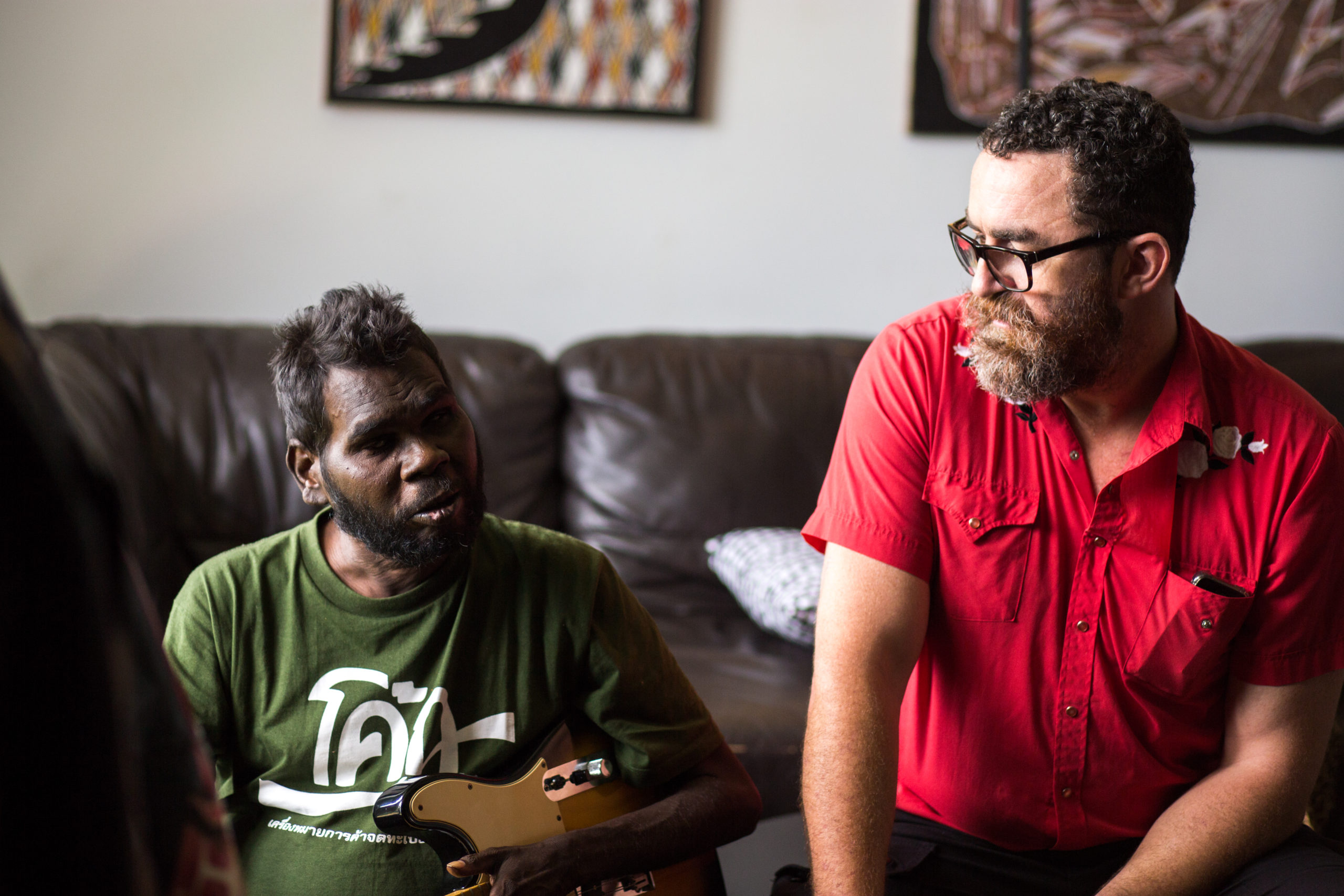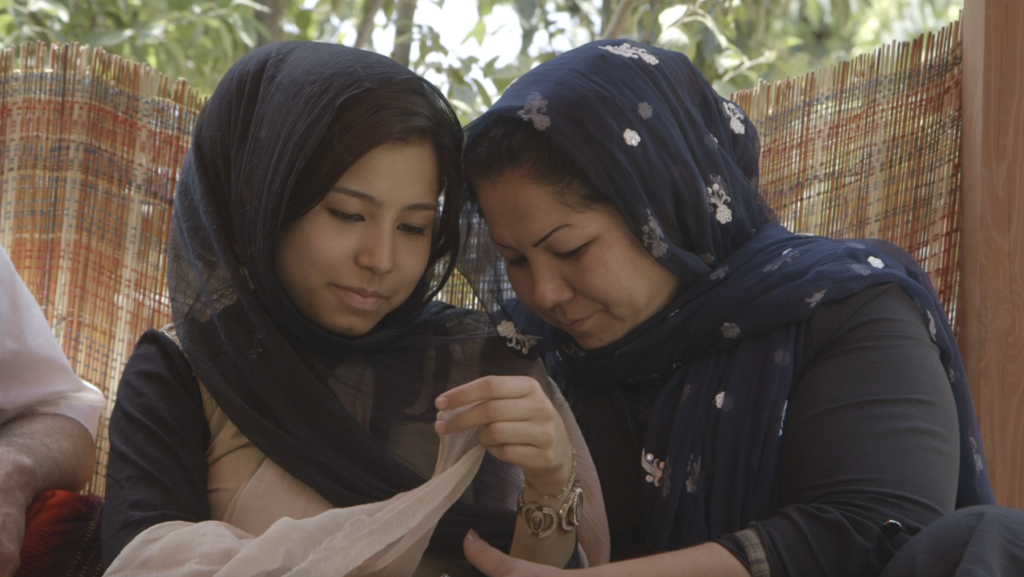“It just hits you right in the heart,” says producer Shannon Swan describing the music of Geoffrey Gurrumul Yunupingu. Known best simply as Gurrumul, the late blind singer of the Yolngu Indigenous tribe was one of the most influential voices in contemporary Australian music. His legacy is the subject of the documentary Gurrumul, directed by Paul Williams and produced by Swan. The film had its North American premiere at Hot Docs this April where POV chatted about the doc and the power of Gurrumul’s music. The film is sure to bring Gurrumul’s inspiring voice to new corners of the world.
When asked how well they knew Gurrumul’s music prior to making the documentary, the filmmakers differ in their responses. “I was familiar with it since the first album came out, just as a member of the CD buying public,” explains Williams. “I actually met Gurrumul in Darwin and the idea of the film came then.”
“I was the complete opposite,” admits Swan. “I just didn’t even pay attention to it. When I moved to Darwin, everyone said I had to see Gurrumul play. So I saw him live and, not being a fan, it was just one of those Darwin tick boxes that you had to do.” However, both filmmakers agree that the haunting poetry of Gurrumul’s music demanded the documentary treatment. There’s so much history and cultural significance within his music for the world to hear.
Gurrumul: The Reluctant Star
Audiences unfamiliar with Gurrumul’s music are bound to have goosebumps as they discover the captivating honey-tuned power of his voice. Although his songs are primarily in Yolngu, his voice has an emotional timbre rivalled by few musicians. The feelings of his songs, which are showcased exquisitely throughout Gurrumul in performance scenes and soundtrack cues, transcend language.
Despite being a compelling screen presence as a musician, Gurrumul is incredibly shy in the film. He rarely says a word unless it’s in a song. The doc portrays him as a reluctant star as he sits bashfully and disinterested during interviews while journalists struggle to extract token sound bites.
Williams explains that Gurrumul simply wouldn’t—and didn’t need to—play the PR game. “You could put an argument forth that he never really opens up to us,” observes Williams. “One of the provisos he made for being involved in the project was that he not be interviewed. We were no different than any of the press regarding that.”
When Gurrumul’s songs are so powerful and personal, though, interviews aren’t necessary. Observational and verité style footage captures his passion for music as he works closely with his producers and readies for a global tour as the world discovers a profound voice that’s been hidden. “His songs are such clear and perfect annunciations of self and of person that from his perspective and for the people who understand the language, he couldn’t be clearer opening up and telling who he is to the world,” adds Williams.
Aunty Susan
While getting Gurrumul to speak could be as arduous as pulling teeth, Swan says there was talk of interviewing him towards the end of production. “There was a discussion that he might do voiceover or an interview,” explains Swan, “but after going through everything, we wanted to keep his mystique. We want people to listen to the music. It expresses who he is and everything about him is contained in those songs.”
The film instead finds a rich voice to speak about Gurrumul’s life and upbringing. His aunt, Susan Dhangal Gurriwiwwi, proves an unconventional narrator as she describes Gurrumul’s childhood growing up blind and with no access to assistance or resources. Aunty Susan is a likable authority figure in the film as she ensures that someone from Gurrumul’s immediate family and community speaks on his behalf.
The filmmakers explain that they interviewed multiple members of Gurrumul’s family and community, but Susan simply provided the best voice in the process. “She just had the most eloquent way of expressing where she came from and Gurrumul’s story,” says Swan. “Her interview was only about an hour and 10 minutes. And then there’s another one from 2010, so overall, we use probably 15 minutes of it in the film.”
Her wise words, dispersed sparingly throughout the film, root Gurrumul’s tale within Australia’s dark legacy of colonialism as she speaks of the hardships her nephew overcame growing up in an impoverished community. “She belies this poetry and gentle philosophy that runs all through the Yolngu-speaking part of Australia,” adds Williams, who notes that Aunty Susan’s strong command of English is rare since most members of the tribe speak it as their fourth or fifth language. Susan doesn’t dwell on the past and instead articulates in narration the hopefulness and optimism that Gurrumul expresses in his songs.
Sight and Sound
The sound design of Gurrumul plays an integral role as it allows one to connect with the power of the artist’s music through immersive layers of audio, including over 50 original music cues. One feels Gurrumul’s world as the filmmakers convey sensorial experiences that move and inform a viewer on levels beyond sight. The filmmakers explain that they worked with Gurrumul on milestone cuts throughout production by having him listen to the film. “We’d flick up an MP3 of the sound and put it on an iPod,” explains Williams. “As our sound mix started to develop with our musical cues, we’d keep updating it. Sometimes we were editing in Melbourne and he was in Darwin, so we’d send up an MP3 [of audio only] or an MP4 and he’d sit with his girlfriend or another Yolngul speaking person and they would describe visually what was happening.”
Swan adds that feedback from Gurrumul inspired them to enrich the soundtrack by observing his acute relationship to sounds. “One of our goals was for him to experience the film in its entirety and understand it,” says Swan. “That was one of the goals in the sound design—like he could sit in a cinema and hear a plane, dog, or truck in the background and recognize those sounds from his community, so it was important to our design to collect those sounds.” The film opens with a title card that notes Gurrumul’s approval of the doc shortly before his death.
Images of the Dead
Gurrumul features another title card that might be surprising to audiences outside Australia or to viewers unfamiliar with films from the land of Down Under. The doc offers a disclaimer warning viewers that the film contains images and recordings of dead people. Williams explains that these disclaimers are an established protocol in Australian broadcasting and cinema. “There are cultural protocols around the depiction of the deceased in like communities like the Yolngu-speaking part that our film’s involved with,” he says. “Generally what happens is that, after someone has passed away, there’s a set period between six months and about 10 years, depending on the wishes of the family, where the images and the audio recordings of the deceased are publicly retired.”
The doc offers a unique case for these disclaimers since several people depicted in the film, including Gurrumul and his mother, died over the course of production. Gurrumul advises from the outset that this case is special and has the approval of the family to show recorded images of their departed loved ones. “The family, conscious of the fact that his cultural legacy was so significant, didn’t want his importance to be lost by an extended mourning period, so they cut it short after about eight months,” explains Williams. “Our initial feeling was that we’d have to shelf the film for eight to ten years. We were surprised and honoured that an exception had been made for the film—and for his new album.”
The film doesn’t mention Gurrumul’s poor health, so his death might seem sudden to audiences discovering his life and music for the first time. However, Williams notes that this omission was at Gurrumul’s request. “In addition to the proviso against interviews he had another, which was that there could be no mention of his health,” explains the director. “Indigenous stories in Australia tend to look at the ongoing tragedy of colonialism—ill health, dispossession, et cetera. He wanted a positive story, as did we.”
A Song of Reconciliation
The doc’s respect for Gurrumul, both in life and in death, illustrates a valuable effort to use film as a tool for reconciliation. Australia, like Canada, is only now grappling with the dark history of colonialism that devastated Indigenous communities and continues to perpetuate systemic inequality. Unlike Canada, which is only now making inroads towards improving representations for Indigenous communities on screen, particularly in efforts for self-representation, Australian cinema is ahead of the game, albeit both are works in progress.
Despite the improvements in film production and sensitivity in Australia, Williams is quick to note that his homeland is doing poorly when it comes to reconciliation. “I’ve been following what’s happening in Canada a little bit,” he says when asked how the counties compare, “so I think there’s certainly some parallels, but you’re ahead of where we are.”
“Indigenous Australia has been, over the last century, presented as a tragedy or as a series of problems, rather than a culture we can learn from. How do we work together? How do we find a way to ‘move forward’ together? How do we reconcile the path that was inflicted on these people?” asks Williams. These questions underline Gurrumul’s music and the film itself. The doc encourages a shift in perspective beyond the limited settler viewpoint.
“The film is ultimately about reconciliation,” says Williams. “It goes beyond a simple music documentary or a biopic about a musician. It is looking at a complex series of relationships that develop over time, through a series of sacrifices and conflicts to create something beautiful together.”
The filmmakers give full credit to Gurrumul’s music for driving the power of reconciliation, love, and hope that resonate in the doc. “His last album is a template for a broader notion of reconciliation,” adds Williams, noting that the film evokes this spirit by offering a guide to a project in which all parties have equity and fair stakes.
“That’s a wonderful outcome for the film overall,” says Williams, “but where is reconciliation for Australia? It has a long, long, long, long way to go. It’s really just at the start of where we need to be.”












